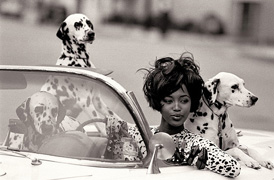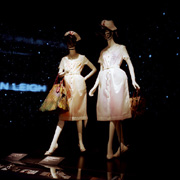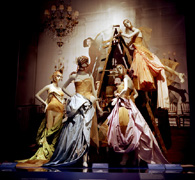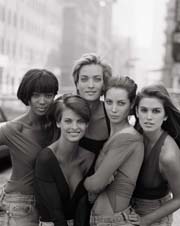 The
Museum Gazetteer
The
Museum Gazetteer 
Fashion Queens are at the MET.
 |
| The
Model as Muse Catalogue Cover. |
Can models be the muses of the designer, creating
themselves the fashions for their generation? This is the theme
of the summer exhibit at the Costume Institute at the Metropolitan
Museum of Art, open until August 9, 2009.
 |
|
Peter Lindbergh (German, b. 1944). Naomi Campbell in Geoffrey
Beene, Vogue, June 1990. Courtesy of Peter Lindbergh. |
On opening night, top super -models of the world like
Cindy Crawford, Gisele Bündchen, Claudia Schiffer, and Kate Moss
attended, there was a lot of fanfare.
Let's discover what is really exhibited at the most
glamorous exhibit of the year.
Exploring the reciprocal relationship between high fashion and
evolving ideals of beauty, "The Model as Muse: Embodying
Fashion" focuses on iconic models of the twentieth century
and their roles in projecting, and sometimes inspiring, the fashion
of their respective eras. "The exhibition examines a timeline
of fashion from 1947 to 1997 through the idealized aesthetic of
the fashion model," said Harold Koda, Curator in Charge of
the Costume Institute.
Each room of the exhibit presents the main style of
each decade in the last 50 years.
 |
From
left to right: Louis Vuitton (French, founded 1854). Marc Jacobs
(American, born 1964). Ensemble worn by Natalia Vodianova, Spring/Summer
2008. White techno silk lab coat; multicolored silk tie-dyed
dress
Courtesy of Louis Vuitton. |
 |
| Dresses
by Dior (French, founded 1947) by John Galliano haute couture
Fall/Winter 2005-2006, at "The Model as Muse: Embodying
Fashion." |
We begin with the elegance of the '50s. An excerpt
from the film "Funny Face" was shown behind the mannequins.
You can discover what is most characteristic of the style. In the
'50s, women wanted to be chic and elegant, wearing Christian Dior.
The strict look of Coco Chanel also was popular. Hepburn became
the muse of Givenchy in "Breakfast at Tiffany's."
The '60s were a revolutionary phase in the history
of fashion. The fussiness of women in the 50's was outmoded and
style transformed into more geometric and flat silhouettes. Freedom
and youth arrived on the fashion podium. The trapeze dress was made
famous by Pierre Cardin.
Style was resolutely Hippie for the '70s. The
bohemian look of Yves Saint Laurent was all the craze. The hippie
punk and disco movement were very present during those years and
bell-bottom trousers became the fashion symbol of the decade. New
designers like Kenzo, Thierry Mugler and Jean-Charles de Castelbajac
arrived on the fashion scene.
 |
Naomi
Campbell, Linda Evangelista, Tatjana Patitz, Christy Turlington,
and
Cindy Crawford in tops, 1990, by Giorgio di Sant’Angelo
(American, born
Italy, 1933 1989). British Vogue, January 1990. Photograph by
Peter Lindbergh (German, born 1944)
Photograph courtesy of Peter Lindbergh. |
The new thing about the '80s was the arrival of world-known
models like Claudia Schiffer and Naomi Campbell. Fashion reached
a larger audience, swallowing all the media and advertising. The
80's look was an awesome mix of colors, details and motifs. At the
same time, the "new wave" boom inspired a rock chic and
a sexy appearance.
 |
| Installation
of the '90s room at "The Model as a Muse." Photo by
Suzanne Trouve Feff. |
Julien d'Ys, the French hairstylist who worked on
the mannequins at the exhibit, made a fantastic mural representing
the grunge and street style of the '90s, including old sneakers
with holes and torn-up jeans. Background music is by Nirvana. The
gallery also includes amazing photographs of top models of the '90s.
"The Model as Muse: Embodying Fashion" is
a very interesting exhibit about fashion history, with more of an
historic than an artistic statement. Each room represents perfectly
the atmosphere of each decade, its style, its colors, its music
and of course its muses. [Suzanne Trouve Feff]